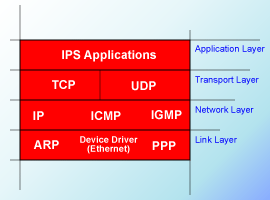SCIOPTA IPS
Designed for Embedded Systems SCIOPTA IPS has been specifically designed to meet the requirements of modern internet protocol network applications in embedded systems.
This gives IPS the advantage over traditional internet stacks that were ported to embedded systems, of having a higher performance and a lower memory footprint.

Flexible Interface
For designers who want to take full advantage of the speed, security and debug possibilities of SCIOPTA messages, an optimized asynchronous message interface is included. An IPS-application can transmit and receive internet protocol data packages in the same way as normal SCIOPTA messages.
SCIOPTA IPS provides also a powerful function interface.
For legacy application, SCIOPTA IPS provides a BSD Socket Interface.
Distributed Systems
With its modular design the SCIOPTA IPS stack cannot only be used in high performance single CPU embedded systems but is also suitable for distributed Multi-CPU systems.
Scalable
Many parts of the SCIOPTA IPS stack are encapsulated in SCIOPTA static or dynamic processes which can be started and stopped individually.
This gives a highly modular design which can be scaled for specific applications.
SCIOPTA IPS Applications
HTTP/HTTPS
The SCIOPTA web server is used to supply data from embedded systems to host web browsers by using standardised protocols and languages.
SMTP
Simple Mail Transfer Protocol, is a protocol for sending e-mail messages between servers.
TFTP
Trivial File Transfer Protocol, is a simple protocol to transfer files between machines on different networks implementing UDP.
DNS
Domain Name System is a service in a TCP/IP network such as SCIOPTA IPS that translates domain names into IP addresses.
Telnet
Telnet is a terminal emulation program for TCP/IP networks such as SCIOPTA using the IPS stack.
DHCP client
This networking protocol is used to automatically assign an IP address to network device from a configuration server.
FTP
File Transfer Protocol, is a communication protocol for sharing files over a TCP/IP network.
IPP
Internet Printing Protocol (IPP) is a specialized communication protocol for communication between client devices and printers (or print servers).
DHCP server
Dynamic Host Configuration Protocol is a protocol for assigning dynamic IP addresses to devices on a TCP/IP network such as SCIOPTA IPS.
Please contact us if you need other high level protocols.
SCIOPTA IPS NG
IPS NG (Internet Protocol Stack New Generation) is a complete rewrite of IPS (Internet Protocol Stack). The main differences between the former and the latter are:
- IPS NG is no longer dependent on GDD/SDD
- IPv6 protocol has been added.